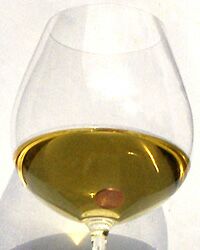|
This article was published in The 30 Second Wine Advisor on Friday, Jan. 20, 2006.
Stinky wine and the penny trick
This unpleasant aroma, like a whole range of other peculiarly stinky characteristics that occasionally show up in wine - cooked cabbage, rotten eggs, even skunk juice or sewer gas - signals the presence of hydrogen sulfide (H2S), an inorganic compound containing sulfur.
Sulfur compounds form naturally in fermenting wine through a process that scientists call "reduction." The exact opposite of oxidation, reduction may occur in wines made under airtight conditions; indeed, some critics theorize that wines kept long-term under screwcaps may be subject to reduction in the cellar because the newfangled high-tech closures might not let enough air in.
The good news, though, is that reduction, in contrast with the nutty, sherry-like taint of oxidation, is usually reversible. As nasty as the sulfury aromas can be, simple aeration through vigorous swirling or decanting will often clear up a light affliction. For more persistent cases, there's the penny trick. It's been almost six years since I last featured this topic, so let's bring it back for another round:
Some bad smells in wine are fatal flaws, but sulfury reductive aromas are relatively easy to banish from your wine by an old trick so simple that you might assume it's a myth: Simply drop a clean penny (or any copper-coated coin) into the afflicted wine. (Or, if you worry over-much about where your penny has been, stir your wine with a polished silver spoon.)
It's not magic, it's only chemistry: The metal in the coin or spoon reacts with the H2S in the wine, quickly converting it into insoluble (and odorless) copper or silver sulfide. I dropped a handy 1 Euro cent coin into the subject wine last night, and found the rubber-tire aroma was diminished almost immediately and completely gone after 10 or 15 minutes. It's a trick worth remembering ... if you're squeamish, though, make sure you scrub the penny first, or use the silver spoon.
There's no point in pillorying the guilty wine, as the condition is temporary and reversible. The sharp-eyed will catch it in due course when I eventually post my tasting report.
One important clarification, by the way: Reductive wine and Hydrogen sulfide and H2S has nothing to do with the much maligned sulfites that prompt warning labels on wines sold in the U.S. and some other countries because of their danger to asthmatics. If you'd like more on that story, see The 30 Second Wine Advisor for
Sept. 9, 2003,
|
 Last night, eager to enjoy a favorite Italian white wine from a respected producer, I got an ugly surprise when I put my nose to the glass and found its expected fruit and minerality significantly obscured by an odd, sulfury scent that resembled nothing so much as the aroma of new black-rubber tires.
Last night, eager to enjoy a favorite Italian white wine from a respected producer, I got an ugly surprise when I put my nose to the glass and found its expected fruit and minerality significantly obscured by an odd, sulfury scent that resembled nothing so much as the aroma of new black-rubber tires.